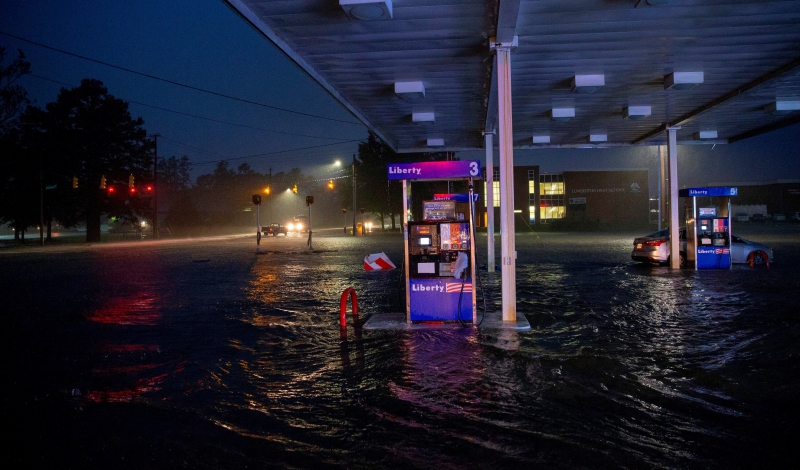
Scholar argues that existing chemical safety regulations fail to prevent hazardous material spills during floods.
In September, Hurricane Ida destroyed thousands of homes and killed at least 13 people in Louisiana.
But the risks to Gulf Coast residents may not be over. Hurricane Ida also reportedly caused toxic spills from flood-ravaged oil and chemical refineries and exposed people to hazardous materials.
These kinds of toxic spills caused by flooding have escaped adequate regulatory controls, argues University of Richmond School of Law professor Noah M. Sachs in a recent article. This failure to act stands in spite of multiple recent disasters that “pose a serious and underappreciated” risk to people across the country as climate change intensifies.
According to Sachs, the recent potential toxic spills in Louisiana are not rare occurrences. Hurricane Sandy caused a 300,000-gallon oil spill in New Jersey. Hurricane Harvey caused toxic flooding from petroleum refinery plants, leading Houstonians to report “skin infections and respiratory problems.” Hurricane Florence caused hog waste lagoons to flood in North Carolina.
Moreover, these toxic spills are expected to occur more often as climate change intensifies the rainfall and flooding accompanying hurricanes. To protect against hazardous chemical exposure, Sachs recommends three primary steps for improving toxic spill regulations.
First, he calls on the U.S. Environmental Protection Agency (EPA) to use its authority under the Clean Water Act to standardize above-ground storage of all hazardous materials. Currently, EPA only standardizes above-ground storage of oil.
Second, Sachs recommends strengthening the Emergency Planning and Community Right to Know Act of 1986 (EPCRA). The current law creates disclosure requirements for firms storing hazardous materials. But Sachs argues that regulators currently lack the enforcement capacity to act on problems identified in disclosures. Sachs argues for strengthening natural disaster responses by increasing funding for local emergency planning committees, which oversee responses to natural disasters. He also favors amending EPCRA “to impose construction, siting, and performance standards for storage of hazardous materials.”
Finally, Sachs calls for zoning restrictions that prevent new industrial facilities that store hazardous materials from being located in “flood-exposed areas.” Sachs acknowledges that these restrictions would be politically contentious but notes that at least one state—Delaware—has had success with similar measures.
Sachs argues that his proposed policy changes would help close the “significant gaps” in how chemical safety regulations currently address toxic substance discharges. Existing regulations, for example, do not limit where industrial facilities can be located, and most states lack robust hazardous material regulatory regimes.
Another gap exists, according to Sachs, with the Resource Conservation and Recovery Act of 1976 (RCRA), which only covers waste byproducts but not the “useful chemicals” that firms plan to use or sell. Sachs argues, however, that useful chemicals can still pose significant threats and need to be accounted for in planning for spills under RCRA.
In spite of the failings that Sachs finds with the current regulatory regime, many industry representatives and scholars oppose new regulation. They argue that firms already have economic incentives to prevent toxic spills. Sachs observes that firms want to avoid losing valuable assets such as oil reserves or other chemicals. Furthermore, firms will regulate themselves because tort liability encourages sufficient safeguards.
Sachs labels such a view the “private law approach” because it relies on legal mechanisms private citizens and companies can enforce among themselves without government interference, such as tort liability and insurance. But he contends that the private approach fails because it can be too difficult for someone who has been exposed to toxic chemicals to trace the source of the hazardous materials. This tracing difficulty becomes especially problematic in toxic flooding situations where numerous companies suffer damage and incur spills, which happened in the Houston area in the wake of Hurricane Harvey.
Sachs points out that another weakness of the private approach stems from the fact that the insurance marketplace frequently does not offer the kind of coverage necessary for toxic spill events. Moreover, for smaller companies, it may not make sense to pay for the cost of insurance if it is more expensive than the value of the firm’s own assets. In those cases, it might cost less for some firms simply to declare bankruptcy should a spill occur.
Sachs concludes that the current private regulatory regime fails to hold offending firms accountable and does not give victims of toxic spills a realistic opportunity to be compensated.
Although some of the impacts of climate change, such as more severe flooding, may not be avoidable, Sachs ends with a note of optimism—with better regulation, government can at least stop hazardous materials from becoming “part of the deluge.”



